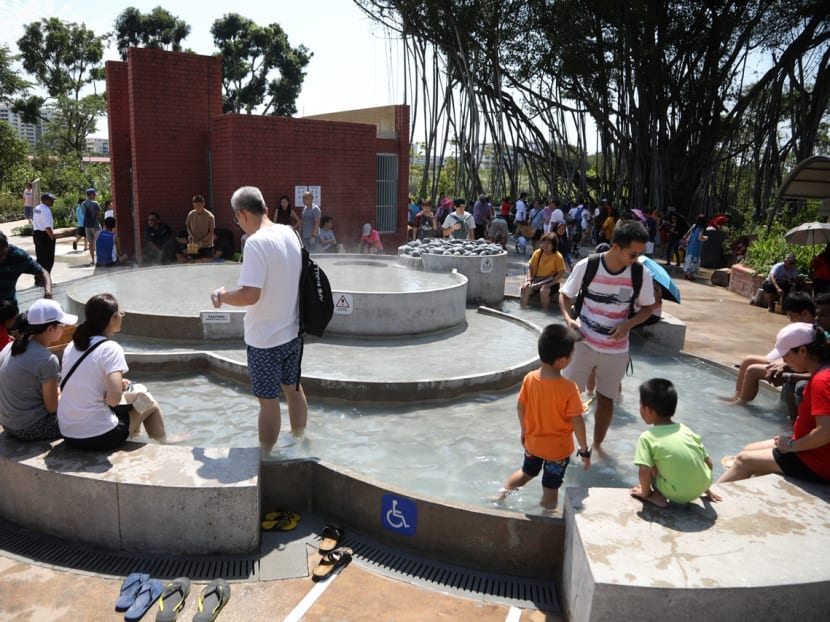Explainer: Geothermal power may become a new source of energy in S’pore soon. How will such energy be harnessed?
SINGAPORE — Geothermal power could potentially become a source of renewable energy for Singapore’s power grid, if a study is able to prove its viability here, Minister for Manpower Tan See Leng said on Tuesday (Oct 26).

Some possible candidates of geothermal resource in Singapore are the hot springs located in Sembawang (pictured) and Pulau Tekong, a researcher said.
- A study is being done by the Energy Market Authority, Nanyang Technological University and other agencies to determine the geothermal potential in Singapore
- Preliminary findings are expected by the end of 2022
- If the results are positive, the authority will undertake more research to determine the viability and scalability of deploying geothermal systems here
SINGAPORE — Geothermal power could potentially become a source of renewable energy for Singapore’s power grid, if a study is able to prove its viability here, Minister for Manpower Tan See Leng said on Tuesday (Oct 26).
The Energy Market Authority (EMA), along with the National Research Foundation of Singapore, is working closely with the Nanyang Technological University (NTU) and various agencies to study and determine the geothermal resource potential in Singapore, Dr Tan said his opening remarks at a forum held during Singapore International Energy Week.
The week-long conference that began on Monday is for professionals, policymakers and thought leaders to to discuss key issues and pressing challenges in the energy industry.
For the study, NTU and the agencies aim to establish preliminary findings by the end of 2022.
Dr Tan, who is also Second Minister for Trade and Industry, said: “If deemed viable, Singapore could potentially adopt geothermal energy and further lower our power sector’s carbon emissions.”
Here is a closer look at this alternative source of renewable energy.
WHAT IS GEOTHERMAL ENERGY?
Geothermal energy refers to heat derived within the sub-surface of the earth.
Associate Professor Alessandro Romagnoli from NTU’s School of Mechanical and Aerospace Engineering, who is jointly leading the geothermal study with members from infrastructure consultancy Surbana Jurong and the research centre TumCreate, said that the potential for geothermal resources is first identified through the occurrence of several surface features such as hot springs and other volcano associated features such as geysers, mud pools, fumaroles — an opening in the earth's surface that emits steam and gases such as sulfur dioxide and carbon dioxide.
If a large amount of heat can be extracted, it is usually converted to electricity.
Otherwise, the heat can also be used directly without doing so.
For example, a geothermal resource with a temperature of more than 140°C can be used to produce electricity, while a lower temperature resource can be used directly for district cooling and water desalination.
Other applications could include: Aquaculture (30-60°C), food processing (60-90°C), fabric dyeing (90-120°C), and cement drying (120-150°C).
WHAT ARE THE ADVANTAGES AND DISADVANTAGES?
The main advantage of geothermal energy is that it can be extracted without burning fossil fuel such as coal, gas, or oil.
And unlike other renewable energy sources, such as solar and wind, it is always available.
Another benefit is that it is relatively inexpensive and savings from direct use can be as much as 80 per cent over fossil fuels, the National Geographic magazine has reported.
In Singapore’s context, EMA said in a press release on Tuesday that as an indigenous source of renewable energy, the adoption of geothermal energy can potentially help to diversify the country's energy sources for energy resilience.
However, National Geographic has reported that there are some environmental problems as well.
The main concern is the release of hydrogen sulfide — a gas that smells like rotten egg at low concentrations.
Other concerns relate to the disposal of some geothermal fluids, which may contain low levels of toxic materials.
Moreover, although geothermal sites are capable of providing heat for many decades, it may eventually cool down.
IS THE REGION RICH IN GEOTHERMAL RESOURCES?
Dr Karen Lythgoe, a research fellow at NTU’s Earth Observatory of Singapore, said that the region is rich in such resources due to its high tectonic activity.
The seismologist pointed out that after the United States, Indonesia is the world’s second largest producer of geothermal energy, with the Philippines close behind.
At present, the only geothermal power plant in Thailand is located at the town of Fang in the northern Chiang Mai province.
Malaysian news agency Bernama reported in 2018 that the country’s first geothermal power plant project in Sabah, which should have been operational at the end of 2017, was found abandoned and overgrown with weeds.
In a 2020 article by energy consultancy ERCE, it was reported that little exploration has been carried out in Southeast Asia for the adoption of geothermal energy because a greater focus has been placed on harnessing hydro, solar and wind power.
Dr Lythgoe suggested that one way to encourage greater adoption of geothermal energy in the region would be through the introduction of tax incentives.
WHERE ARE SINGAPORE’S POTENTIAL GEOTHERMAL SOURCES?
While it did not disclose the exact locations, EMA said that the study will focus on determining the geothermal resource potential in northern and eastern Singapore, because they have been found to have higher surface temperature measurements.
Some possible candidates, Dr Lythgoe said, are the hot springs located in Sembawang and Pulau Tekong.
“But it may be that the best prospects are away from the hot springs, depending on the method used to exploit geothermal energy.”
Associate Professor Benoit Taisne from NTU’s Asian School of the Environment said that getting efficient geothermal energy is not just about drilling straight under a hot spring.
Assoc Prof Romagnoli, who is also the cluster director for multi-energy systems and grids at NTU’s Energy Research Institute, said that the origins of the source of heat at the Sembawang hot springs are still unknown, for instance.
“However, large-scale maps in literature indicate that Singapore has anomalous heat flow. The cause for the anomaly could be attributed to the presence of hot granite rocks.”
It is for reasons such as this that Assoc Prof Taisne, who is also the principal investigator within the Earth Observatory of Singapore's volcano group, said that there is a need to fully understand the deeper structures within the earth, and the source of the water that is being seen at the surface.
“Only a complete geophysical and geological survey would answer those questions and minimise the risk of drilling at the wrong place.”
IS THIS A NEW IDEA?
Dr Lythgoe said that some geothermal models have been proposed by others in the past.
“Previous work on assessing geothermal resources, through the drilling of a well, had some limitations, including the location, which we now know to be sub-optimal.”
She added that other possible reasons why previous studies did not yield good results could be a lack of a geophysical assessment before drilling, and she thus stressed the importance of a comprehensive, multidisciplinary geophysical study.
On the issue of the technical challenge of drilling into granite to extract heat from hot rocks, Assoc Prof Romagnoli said that it is more about economic feasibility.
For example, the cost of drilling “increases rapidly with depth, that it quickly becomes too costly”, he added.
That said, he believes that emerging cost-effective and high throughput technologies could soon make the deployment of geothermal plants in Singapore economically viable.
EMA said on Tuesday that technological advances such as the Advanced Geothermal Systems have opened up the possibility of geothermal application in Singapore, by harnessing heat from deep hot dry rock, with “minimal impact to environment and safety”.
WHAT HAPPENS AFTER THE STUDY?
EMA said that if the preliminary findings from the exploratory study yield positive results, the authority will explore undertaking further research to determine the viability and scalability of deploying geothermal systems here.
“Singapore could potentially see the adoption of geothermal energy for power generation in the future and be one of the first countries to deploy next-generation geothermal systems in a densely populated city,” it said.
“More importantly, it would support Singapore’s effort to lower its power sector’s carbon emissions and help meet its climate change targets.”








